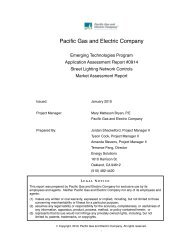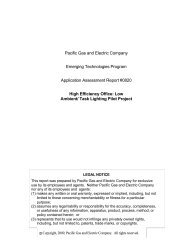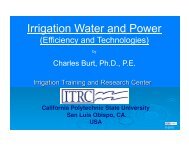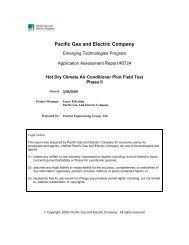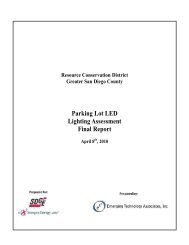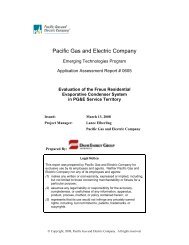Laboratory Evaluation of the OASys Indirect/Direct Evaporative
Laboratory Evaluation of the OASys Indirect/Direct Evaporative
Laboratory Evaluation of the OASys Indirect/Direct Evaporative
You also want an ePaper? Increase the reach of your titles
YUMPU automatically turns print PDFs into web optimized ePapers that Google loves.
<strong>of</strong> power versus airflow takes over and causes <strong>the</strong> ECER to fall <strong>of</strong>f at higher airflow rates. This is why<br />
<strong>the</strong> ECER number for this system was highest at <strong>the</strong> medium fan speed, which turned out to be <strong>the</strong> fan<br />
speed that came closest to <strong>the</strong> peak for this system. As <strong>the</strong> ECER rating number becomes more prevalent,<br />
manufacturers may begin to design <strong>the</strong> fan speed <strong>of</strong> <strong>the</strong>ir systems around its maximum ECER to make<br />
<strong>the</strong>m stand out, which may not be <strong>the</strong> best solution for <strong>the</strong> consumer. ECER should always be reported<br />
with supply airflow.<br />
Perhaps a refinement <strong>of</strong> <strong>the</strong> ECER is required for variable or multiple speed systems is needed to account<br />
for <strong>the</strong> times that <strong>the</strong> system will operate at lower fan speeds than <strong>the</strong> maximum, which will likely be<br />
most <strong>of</strong> <strong>the</strong> time. Additional system modeling or testing could be done with <strong>the</strong> goal <strong>of</strong> determining a<br />
seasonal ECER (integrated total cooling provided by <strong>the</strong> total power consumed), and a set <strong>of</strong><br />
measurements that could be done to predict this result to create a better system rating. While a better<br />
indicator, this still does not include <strong>the</strong> reduced humidification done by systems having indirect<br />
components, like <strong>the</strong> <strong>OASys</strong> .<br />
Based on its system effectiveness, <strong>the</strong> <strong>OASys</strong> should be qualified for <strong>the</strong> highest rebate tier, if <strong>the</strong>y are<br />
reinstated. The attractiveness <strong>of</strong> this system for providing a more comfortable environment will need to<br />
be high enough to counter <strong>the</strong> higher relative cost <strong>of</strong> <strong>the</strong> system, even after a rebate.<br />
REFERENCES<br />
1. ASHRAE, “Handbook <strong>of</strong> Fundamentals, Chapter 27: Climatic Design Information”, American<br />
Society <strong>of</strong> Heating, Refrigerating and Air-Conditioning Engineers, Inc., 1791 Tullie Circle, NE,<br />
Atlanta, GA 30329, 2001.<br />
2. ANSI/ASHRAE Standard 37-1988, “Methods <strong>of</strong> Testing for Rating Unitary Air-Conditioning and<br />
Heat Pump Equipment”, American Society <strong>of</strong> Heating, Refrigerating and Air-Conditioning<br />
Engineers, Inc., 1791 Tullie Circle, NE, Atlanta, GA 30329, 1988.<br />
3. ANSI/ASHRAE Standard 41.2-1992: “Standard Methods for <strong>Laboratory</strong> Airflow Measurements”,<br />
American Society <strong>of</strong> Heating, Refrigerating and Air-Conditioning Engineers, Inc., 1791 Tullie Circle,<br />
NE, Atlanta, GA 30329, 1992.<br />
4. ANSI/ASHRAE Standard 133-2001, “Method <strong>of</strong> Testing <strong>Direct</strong> <strong>Evaporative</strong> Air Coolers”, American<br />
Society <strong>of</strong> Heating, Refrigerating and Air-Conditioning Engineers, Inc., 1791 Tullie Circle, NE,<br />
Atlanta, GA 30329, 2001.<br />
5. ANSI/ASHRAE Standard 143-2000, “Method <strong>of</strong> Test for Rating <strong>Indirect</strong> <strong>Evaporative</strong> Coolers”,<br />
American Society <strong>of</strong> Heating, Refrigerating and Air-Conditioning Engineers, Inc., 1791 Tullie Circle,<br />
NE, Atlanta, GA 30329, 2000.<br />
6. ARI Standard 210/240, “Standard for Unitary Air-conditioning and Air-source Heat Pump<br />
Equipment”, Air-conditioning and Refrigeration Institute, 4301 N. Fairfax Drive, Arlington, VA<br />
22203, 2003.<br />
7. Australian Standard AS 2913-2000, “<strong>Evaporative</strong> Air Conditioning Equipment”, 2000.<br />
8. Davis, R. Pacific Gas and Electric Company PY2003 Emerging Technology Application Assessment<br />
Report #0307, “<strong>Evaluation</strong> <strong>of</strong> Advanced <strong>Evaporative</strong> Cooler Technologies”, PG&E/TES Report 491-<br />
04.07, February 2004.<br />
9. Davis, R. Pacific Gas and Electric Company PY2004 Emerging Technology Application Assessment<br />
Report #0401, “<strong>Evaluation</strong> <strong>of</strong> a Thick Media <strong>Evaporative</strong> Cooler”, PG&E/TES Report 491-04.31,<br />
November 2004.<br />
10. Davis, R. Pacific Gas and Electric Company PY2005 Emerging Technology Application Assessment<br />
Report #0402, “<strong>Laboratory</strong> <strong>Evaluation</strong> <strong>of</strong> <strong>the</strong> Coolerado Cooler <strong>Indirect</strong> <strong>Evaporative</strong> Cooling Unit”,<br />
PG&E/TES Report 491-05.6, March 2006.<br />
491-06.12.doc 22




